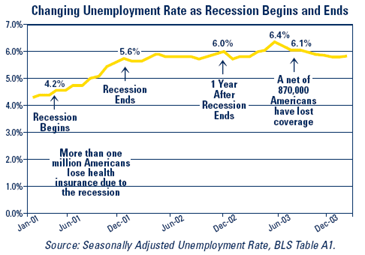
Q&A with John Cawley, Ph.D.
John Cawley, Assistant Professor in Cornell's Department of Policy Analysis and Management, recently co-authored the paper, "Health Insurance Coverage and the Macroeconomy," for ERIU. Cawley's and fellow Cornell Assistant Professor Kosali Simon's work sheds light on an area that surprisingly has been the focus of little research.
Q: How do macroeconomic trends affect the number of people who have health insurance?
A: We found that the unemployment rate is what really matters. The U.S. had two significant macroeconomic events back to back - a national recession from March of 2001 to November of 2001, preceded by the longest continuous economic expansion in U.S. history. We were curious as to what extent those events affected the probability that people had health insurance coverage.
We found recession is the wrong measure of what matters regarding health insurance coverage. Unemployment rate is really what turns out to be the strongest determinant of health insurance coverage, as most people's coverage is linked through an employer. And unemployment rates peak after the end of a recession.
Q: Please quantify the degree to which these bigger trends impact health insurance coverage.
A: A one percentage-point increase in unemployment, like a rise from five to six percent, decreases the probability of coverage by well under one half of one percent. While that may not seem like a significant probability of losing health insurance, when you multiply that by 86.6 million men in the U.S., for example, it gives you huge swings in health insurance coverage.
Q: Do public health insurance programs pick up the slack?
A: For children, we find that SCHIP and Medicaid do operate counter-cyclically. When unemployment rates rise, the government steps up and covers more children.
Q: From an economist's viewpoint, what changes can policymakers make to prevent increases in uninsured rates during rising unemployment?
A: Government-provided health insurance coverage for men is not counter-cyclical. When unemployment rates shoot up, you don't see many more men being covered by the government. There are very gender-specific ways we have chosen to counteract uninsurance caused by the macroeconomy. We've decided to protect women and children and not really adult men. I wouldn't comment on whether that is right or wrong. But clearly one way to soften the blow of the macroeconomy on health insurance coverage is to do something for adult men.
Q: Why is it important for policymakers to know there's a significant connection between higher unemployment and higher uninsured rates when considering solutions?
A: The macroeconomy matters to health insurance coverage. Recession is not what you want to focus on. It would be a mistake to think that because the U.S. is not currently in recession that we still don't have people losing health insurance. Also, because SCHIP and Medicaid aren't fully counter-cyclical, the net effect of higher unemployment is still that more children lose health insurance than gain it.
|
UPCOMING |
This Research Highlight is the fifth in a series of research-based policy documents that address current questions and issues related to the health care coverage debate. The next Research Highlight will examine the effect of Medicaid expansions for parents. Research Highlights, conference proceedings and other materials can be found on ERIU's website at . |
Full interview and other ERIU Research Highlights
Summary of findings, data, and methods

ERIU Working Paper #24 (Adobe PDF)
Back to top
 Funded by The Robert Wood Johnson Foundation, ERIU is a five-year program shedding new light on the causes and consequences of lack of coverage, and the crucial role that health insurance plays in shaping the U.S. labor market. The Foundation does not endorse the findings of this or other independent research projects. Funded by The Robert Wood Johnson Foundation, ERIU is a five-year program shedding new light on the causes and consequences of lack of coverage, and the crucial role that health insurance plays in shaping the U.S. labor market. The Foundation does not endorse the findings of this or other independent research projects. |
